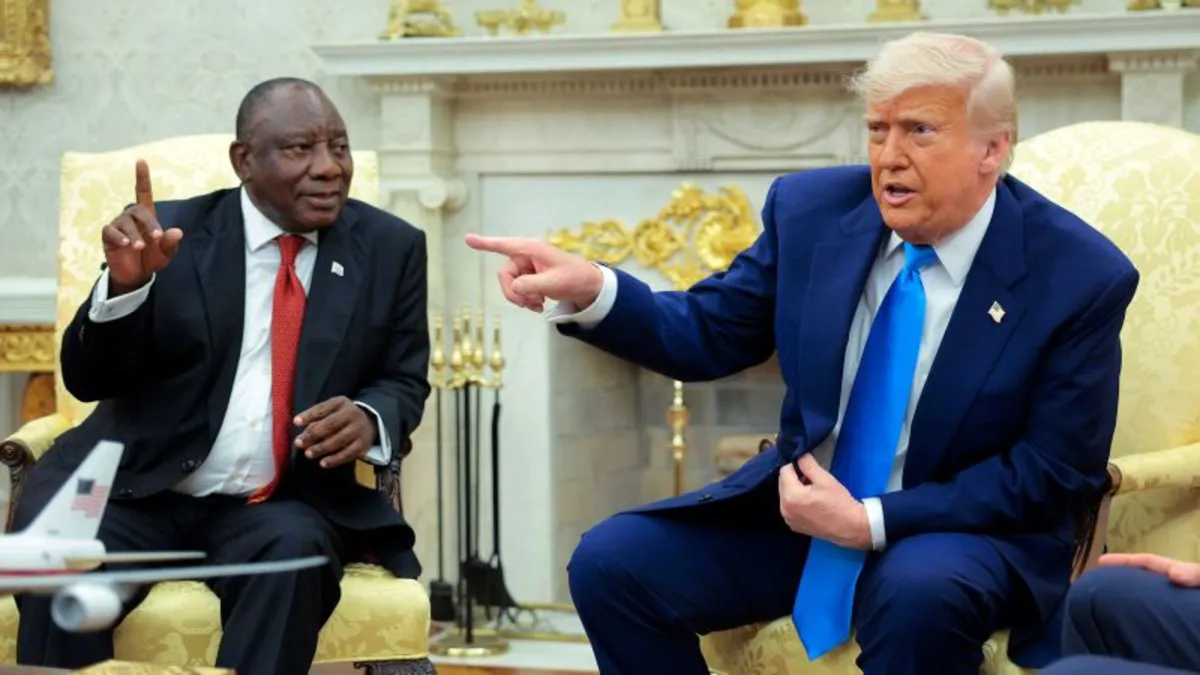
Moments before President Donald Trump welcomed his South African counterpart, Cyril Ramaphosa, into the Oval Office, White House aides were seen transporting two large-screen televisions into the West Wing. Little did Ramaphosa know that this visit would take an unexpected turn. As the meeting commenced, Trump dimmed the lights and introduced a video that he claimed showcased evidence for his unfounded assertions about the persecution and “genocide” of White South Africans.
A visibly shocked Ramaphosa, who had just engaged in light conversation with Trump about golf, stood silently as he watched the video. The South African leader, an experienced diplomat and former chief negotiator under Nelson Mandela, struggled to mask his discomfort during this orchestrated display. Trump’s team had prepared articles for the President to brandish in front of the cameras, claiming to support his allegations of White “genocide” in South Africa.
This moment was not entirely unexpected, as Trump has been vocal in promoting fringe claims regarding the supposed plight of White farmers in South Africa, alleging that they are experiencing land seizures and violence. Just a week prior, 59 White South Africans were granted refugee status by the Trump administration, highlighting the administration’s controversial stance on this issue.
Despite the lack of evidence supporting Trump’s claims, CNN has conducted investigations into the alleged White “genocide” in South Africa and found no substantiation for these accusations. Trump, however, insisted that he had received reports from “thousands” of individuals concerning this matter. Throughout the meeting, Ramaphosa attempted to clarify the situation in his country, but Trump remained adamant, repeatedly emphasizing phrases like “death, death, death” while flipping through printed articles.
It was evident that Trump and his team had meticulously planned this meeting to bolster their narrative of White persecution. Aides noted that they anticipated the topic would emerge during the Oval Office discussions, especially after Ramaphosa expressed hopes of swaying Trump’s misguided views prior to his trip to Washington. This preparation included a video featuring Julius Malema, a prominent opposition politician, who has been known for his controversial statements about White farmers.
Shortly after the video aired, the White House shared it across its official social media platforms, indicating a strategic approach to disseminating their narrative. Trump’s allies applauded this confrontational tactic, viewing it as a demonstration of the President holding world leaders accountable for their actions. This organized rollout suggested an eagerness from Trump and his team to utilize the meeting to further their claims, even as Ramaphosa aimed to discuss trade and other geopolitical matters.
In response to the video and Trump’s assertions, Ramaphosa emphasized, “What you saw in the speeches that were being made—that is not government policy. We have a multiparty democracy in South Africa that allows people to express themselves.” He insisted that the South African government’s policies stand in stark contrast to the claims made by Trump.
Trump’s fixation on the alleged mistreatment of White South Africans is not a new phenomenon; he had previously expressed concerns for White farmers during his first term. However, his claims of oppression and “genocide” have notably intensified in the early months of his second term. The administration has expedited the processing of Afrikaner refugees while halting refugee applications from other nationalities.
Moreover, Trump’s criticism of South Africa’s post-apartheid laws, intended to rectify historical racial inequalities, aligns with his broader agenda to dismantle diversity initiatives within the United States. His views have received backing from notable figures, including South African-born billionaire Elon Musk, who was present during the meeting. Musk, who had previously accused South Africa of obstructing his Starlink internet service due to Black ownership regulations, returned to the White House for this contentious meeting.
Despite efforts by South African leaders to propose solutions that would facilitate Musk’s business operations in South Africa, the meeting failed to ease tensions. During the Oval Office spectacle, Trump dismissed the idea of giving Musk a platform, stating, “I don’t want to talk to him about that. I don’t think it’s fair to him.” This encounter serves as a stark reminder of the complexities and tensions surrounding U.S.-South Africa relations, with Trump using his platform to amplify controversial claims while sidestepping diplomatic discussions.